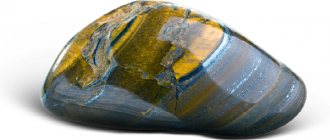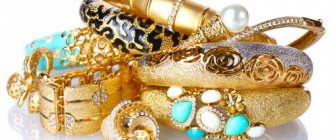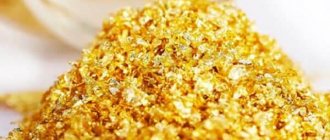Precious or noble metals include the various platinum group metals, silver and, of course, gold. These metals received this name due to certain features - they are resistant to acids, corrosive and oxidative effects of the external environment, as well as the presence of gloss (or shine) in products. The physical and chemical properties of gold are now well studied and described in detail.
General information and history of origin
It is believed that gold is a valuable metal that humanity first became acquainted with in the Stone Age due to its massive distribution in its primary state. The properties of the metal made it possible to make weapons and objects for various purposes from it, which were discovered by archaeologists since ancient times, and dated back to the 4th-5th millennium BC. e.
In the 3rd millennium BC. e. the metal was already known in Egypt, India, China, and Mesopotamia. Ancient jewelry made at that time contained silver, copper and other metals.
Only 6th century. BC e. 99.8% pure gold was found in Egypt. During the Middle Kingdom, Nubian deposits were mined, giving rise to the name Nub gold.
Native gold is the main form of metal found in nature. It is present in hydrothermal deposits, forming gold ores, unevenly distributed in fractured vein quartz and sulfides.
When ores oxidize on the surface of the earth, it dissolves and redeposits. Destruction processes lead to the release of native gold particles and their accumulation in placers.
Sample system
The quality of gold and its quantity in alloys is controlled by the state. In the CIS countries, the system of samples of jewelry alloys that existed back in the USSR is considered generally accepted. Thus, products with the following samples are most often found on sale:
- 375 – the specific gravity of gold in the alloy is 38%. It includes copper and silver. Gold of this standard tarnishes in air. It has a yellow or reddish tint.
- 500 – gold content is 50.5%. The alloy contains copper and silver. It is characterized by low castability.
- 585 (583) – specific gravity of gold 59%. The alloy includes metals such as palladium, silver, copper, and nickel. It is durable, hard, and resistant to air.
- 750 – the alloy contains 75.5% gold. It contains palladium, nickel, platinum, silver, copper. Products made from this gold are highly polished, durable and hard. They are easy to process. The color range is very wide. The alloy can be green, bright yellow, pink, red.
- 958 – contains 96% pure gold. This alloy is rarely used because it does not polish well and does not have the required color saturation.
- 999 is pure gold, which is most often represented by bank bullion.
Chemical, physical, optical properties of gold, classification
Pure gold has low hardness and melts at a temperature of 1064°C . The metal is ductile, malleable, and bends easily. It is also resistant to moisture, does not react with acids, salts, alkalis, but can dissolve in acids (nitric and hydrochloric) in a ratio of 1:3.
It reacts chemically with chlorine, bromine, iodine.
Chemical properties
As history says, such an element as gold was known to people long before it was established in the periodic table. But even in the table this element is of great importance. Over the centuries, different chemists have conducted experiments on this material at different times. It was found that sulfur, as well as oxygen, negatively affect most basic metals. But scientists have found that these substances do not affect gold in any way. Only those atoms that are on the surface are slightly affected.
If you know the content of a fossil, you can determine all its properties and characteristics. If the reaction does not occur with some chemical elements, then with some there is an effect even at room temperature. Mineral acids have no effect on gold. This is the principle used to determine whether a metal is real. There is also a specific process that helps determine whether a particular piece of jewelry is genuine. To do this, the object must be completely placed in nitric acid.
If the decoration is real, then even when interacting with acid, the color will not change. But if instead of gold there is a completely different metal, then a chemical reaction can occur.
Field and production
It is believed that the Egyptians were the first to mine the yellow metal. Chronicles recorded metal mining in the Arabian-Nubian province. Deposits were also found in Spain and Austria-Hungary.
In total, the world produces an average of 2,500 tons of gold per year. The largest deposit is located in South Africa. Up to half of the world's production is extracted here. Next come China, Australia, USA, Peru, Russia, Canada, Mali.
Countries with large natural reserves:
| A country | Reserves (t) |
| USA | 13427,6 |
| Canada | 13367,4 |
| South Africa | 13228,5 |
| Russia | 9306,2 |
| Australia | 7331,8 |
| Chile | 4182,6 |
| Mexico | 3872,8 |
The largest gift to humanity was kept in South Africa (Africa), where an accumulation of about 70,000 tons was discovered in an area measuring 100x270 km in 1873. More than half has already been mined.
Photo and appearance of metal
Grains are gold fractions up to 15 g in size. They have a minimum of impurities, and their extraction is economically efficient.
Do you wear gold?
Pieces weighing more than 15 g are called nuggets. They do not contain pure gold. And impurities can change the color of the metal beyond recognition, which makes it difficult to identify a nugget, and only a specialist can determine whether it belongs to valuable metals.
What color is gold?
Jewelry is not made from pure gold because it is soft and not suitable for daily wear. To eliminate this defect, other substances are added to gold, so it changes its properties, value and shade.
Classification of gold alloys depending on the color palette:
- Yellow gold. Template color for perception. In the jewelry industry, it is supplemented with silver and copper, which increases the wear resistance of products of varying degrees of complexity.
- White gold. This color of metal is mined by incorporating palladium, nickel, silver, and platinum into gold. The alloy with platinum is valuable. Decoration based on it does not collapse, does not deform and retains its attractive appearance for a long time. Nickel products are cheap, they wear worse and can cause allergies.
- Black gold . It can be obtained in certain ways: combining cobalt and chromium, coating it with black rhodium, using a laser pulse, or treating it with amorphous carbon.
- Green gold. This alloy was known in ancient times. It was called electrum - a type of native gold, which was an alloy with silver with a green tint. The share of silver in it, as a rule, predominates. Green metal differs from natural alloys by a pronounced green tint, and some metals according to the well-known standard are in the ratio of 73% gold and 27% silver.
- Red gold . It is produced by adding an alloy consisting of copper and zinc to a valuable metal. Jewelers prefer to use red gold because it is durable, which helps them create exclusive jewelry without worrying about possible deformation.
- Pink gold . An alloy of gold, silver and copper. Many jewelers make real masterpieces from it, attracting the attention of true connoisseurs of jewelry art. It is 585 (58.5% gold, 32.5% copper, 9% silver) or 750 (75% gold, 12.5% copper, 12.5% silver).
- Brown gold. Due to its hardness, this alloy is used to design watch movement cases. As a standard, it has a 585 or 750 sample with a large presence of copper in the rest of the alloy. The brown color comes from repeated chemical treatment of the jewelry. The material acquires a brown tint after special procedures.
Jewelry brands offer a large selection of shades and colors of gold, creating new unusual alloys.
Samples
To determine the quality of metal, a sampling system was invented that shows the volume of pure metal in the product:
- 999 sample . These jewelry are rare and cannot be found in store windows. Due to the minimal impurity content (up to 0.01%), this gold is called “four nines”. Used to create bank bullion.
- 960 sample. Gold leaf. Its chemical properties make it possible to roll metal into ultra-thin sheets. In this case, the product will not have cracks or irregularities, which is due to the increased ductility of the metal. These plates are called tinsel, which is used for decorative purposes and in the food industry (additive E175).
- 958 sample . The alloy contains up to 96.3% gold. Silver and copper act as additional elements. It is characterized by yellow color, plasticity, and resistance to environmental factors. Wedding rings and pendants are made from this sample.
- 750 sample . The alloy contains up to 75.5% of the base metal, other components are platinum, silver, palladium, nickel, copper. The metal is durable and can be polished well, which is why products made from it last a long time and shine brightly.
- 585 sample . This alloy is quite in demand in the jewelry industry. It contains up to 59% gold. It is endowed with hardness, durability and does not fade. Can be white, red, yellow and green, based on the number of proportions of elements included.
- 375 and 500 samples . They are not used in the jewelry industry. Alloys instantly fade in air, losing their shine and attractive appearance, which limits their use.
- 250-333 sample. Due to the insignificant composition of gold, the alloy oxidizes in air and begins to corrode and quickly tarnish. It is used in foreign jewelry production in the manufacture of cheap jewelry for mass demand.
When purchasing jewelry, it is important to check its authenticity. Each product has a special imprint - a stamp where the sample is indicated.
What alloys are there?
Even in ancient times, when minting coins, they used an alloy of gold and silver 4:1 or 3:1. In the modern world, the composition of alloys is supplemented by:
- cadmium (Cd);
- copper (Cu);
- nickel (Ni);
- palladium (Pd);
- platinum (Pt);
- silver (Ag);
- zinc (Zn).
These additives give the necessary color to the alloy and change its properties. The inclusion of silver makes gold viscous and ductile, reduces the melting point, and changes its color. The addition of copper imparts hardness, maintaining malleability and ductility, but at the same time worsens the protective characteristics.
It also gives it a red tint. Palladium guarantees the alloy ductility, malleability, and also changes its color. If the palladium portion is 10%, the color becomes white.
Areas of application of gold
Apart from being used as decoration and jewelry material, this yellow metal is used in a wide variety of industries.
Since the metal is easily processed, it is convenient to use it to produce alloys with other metals, which acquire a presentable appearance, as well as resistance to corrosion and other types of external influences.
Industrial use
Due to its low electrical resistance, the metal is often used for the manufacture of electroplated coatings, conductors, and also for insulating the contact surface. Gold is also actively used to create electronic microcircuits, as well as for terminals and connectors for them.
Gold alloys are in demand for the manufacture of welding materials, which are necessary for the production of thermoelectric converters and other highly sensitive devices (such as galvanometers). This list should also include the following areas:
- Telecommunications and nanotechnology.
- Robotics, cybernetics, electronics.
- The space industry (given the reflective properties of the metal, gold is an indispensable material for the construction of rockets, satellites and living compartments of space stations), aviation, military equipment.
- Petrochemical production, as well as energy.
- Transport industry.
Inserting the thinnest gold plates into the glass of buildings, as well as ships and other vehicles, helps prevent the surface from heating (again, due to the fact that this metal reflects the sun's rays well).
For airplanes and large ships, the ability of gold to impart anti-fog properties to windows is important, provided that electricity is passed through such glass.
Medicine and Dentistry
Obviously, due to the incredible resistance of the metal to corrosion and oxidation, it has found wide application in dental prosthetics. The aggressive environment of the oral mucosa, as well as bacterial saturation, do not have a negative effect on the gold filling. Of course, for durability, not pure gold is used, but alloys with zinc, platinum, silver and copper.
These properties of the yellow metal were known back in the old days, but the possibility of using gold particles in pharmacology was discovered not very long ago. The use of “golden” drugs is aimed at treating the following diseases:
- Rheumatoid arthritis and joint diseases. For treatment, drugs such as Crizanol (Aurotioprol), Tauredon, Auronofin are used.
- Erythematous lupus. In some cases, an injection of gold thiosulfate may be prescribed.
- Tuberculosis. An example is preparations based on compounds of gold and chitosan (the chitin coating of arthropods), which effectively combat Koch's bacillus.
- Oncological diseases. Many researchers propose the use of nanotechnology against malignant tumors (in particular, the use of gold nanoparticles followed by radiotherapy).
Fans of traditional medicine can name many beneficial properties for humans that gold amulets and amulets possess. To understand what healing qualities an ordinary trinket has, you should know that gold has always been considered a disinfecting metal that has a beneficial effect on the skin.
There is definitely some truth in this, since the safety of this material in terms of allergic properties has been scientifically proven.
Eating
Adding edible gold to dishes used to be a common phenomenon, since a gilded meal, according to the beliefs of many peoples, brought a person closer to immortality and other divine qualities. Food colored gold was considered endowed with magical powers and was available only to very wealthy people .
Magical properties and influence on humans
Magical practice has always recognized the strong and insidious energy of gold. Not everyone can handle this power. Gold can both attract wealth and good luck, and lead to death by fogging the mind. For those who are able to cope with it, metal will become a reliable talisman that:
- It will give you such positive qualities as confidence, determination, fairness, and the desire for excellence.
- It will pacify excessive emotions, make a person balanced, able to control outbursts of irritation and anger.
- Helps you think rationally and make the right decisions
- It will get rid of negative influences and protect against the evil intentions of people around you.
Gold helps those who believe in its power, ask for help and express their gratitude.
For women
For women, metal will help them plan their future correctly, correct their fate, and improve their quality of life. Metal makes its owner liberated, freer to choose her path. The girl makes contact better, a lot of fans and admirers appear around her.
For men
Gold will give men self-confidence and success in entrepreneurship and financial matters. Metal will allow you to develop diplomacy, a sense of balance and tact.
Medicinal and beneficial properties
In addition to its physical value, the expensive metal is also credited with having a positive effect on human health. Continuous wearing of gold is believed to help:
- Strengthen the body's defenses.
- Normalize thyroid function.
- Stabilize the functioning of the heart and vascular system.
- Eliminate deafness, improve vision.
- Cure respiratory diseases.
- Increase activity and performance.
- Stimulate brain activity, improve memory.
- Lift your mood, invigorate, protect against depression, relieve symptoms of chronic fatigue.
It is recommended to use gold for medicinal purposes for those who do not have an individual reaction to it . As a result of metal intolerance, skin allergies, depression, deterioration of hair growth and even tooth decay can occur.
How and who is recommended to wear gold
In order for gold jewelry to give you only pleasure, complement your image, style, and emphasize your status, you need to wear it correctly and not neglect the general rules.
Zodiac sign
Gold has a great influence on a person’s destiny, so you should know which sign it suits.
- According to astrologers, metal will become a reliable amulet for such zodiac signs as Leo , Taurus , Aries , as it helps its owners overcome any difficulties in life with faith in their own strength.
- Virgo , Cancer , Libra , Pisces should limit wearing gold; it is better for them to give preference to silver.
- Read more about each zodiac sign here .
All other zodiac signs can safely, without fear, use the valuable metal and its healing and mystical power.
What stones and metals is metal compatible with?
To enhance the positive impact of the product, when choosing jewelry, you need to know which stones gold is compatible with.
The noble alloy harmonizes with diamond, lapis lazuli, ruby, hyacinth, amber of various shades, and transparent peridot.
You cannot combine gold with jade, emerald, garnet, languid pink topaz, or jasper. Since gold cannot withstand high-density, dark-colored minerals that block the passage of the sun's rays.
The Physical Side of Gold
Among the valuable possibilities of gold, from a physical point of view, we can highlight:
- Plasticity and malleability. Gold is such a ductile material that it can be used to make sheets 0.5 mm thick or forge a thin long wire with a diameter of 2 kilometers and a weight of 1 gram. This property is widely used in jewelry, since making jewelry by hand requires the plasticity of the material to give it an openwork shape. Although, on the other hand, this same property sometimes interferes in jewelry making. Due to the softness of pure gold, alloys of other metals must be added to it, otherwise the product will not hold its shape. Thanks to its ductility and malleability, gold can be used in microcircuits, but this is rarely done due to the high cost of the material. Gilding is the coating of a product with thin gold sheets. The thinness of the sheet is so small that its price is low, and the item looks truly luxurious. Although any jeweler can easily check the presence of gilding. From the outside it looks expensive.
- Electrical conductivity, low resistance. Many metals have this property, but gold has a very high electrical conductivity. Therefore, the precious metal could easily be used as conductors and other elements in microcircuits and mechanical parts. The physical properties of gold are very conducive to this, but the cost of the starting material is too high. And there is not enough gold to use this feature on an industrial scale.
- The hardness of the metal on the 10-point Mohs hardness scale is 2.5-3.5, which is quite a bit for a metal. If you measure the hardness of a substance using the Brinell method, you can get a value of 18 kg/mm2. This property indicates how much the metal resists the penetration of another body into it. If you press on a bar of pure gold with your hands, you can leave a dent or scratch it with your fingernail - that's how low the hardness of gold is. For this reason, bank bullion is sold and stored in cases. In ancient times, when coins made of pure gold were in use, this was not entirely convenient, since such money quickly wore out and lost its shape and attractiveness. Their softness was easy to taste. Therefore, the idea of using pure gold coins was abandoned.
- Density is another property of gold that gives it value. The thing is that gold is 19.3 times heavier than water. The high density of the metal is the basis for the first occurrence of the substance in nature. The whole point is that gold came out of the bowels of the earth, was washed away by river waters and settled near the banks in shallow water. Therefore, the method of extracting gold by hand during the “gold rush” was based on the fact that river silt was collected and sifted through several sieves, and grains of gold always settled at the bottom. The density of gold also makes it possible to use it in smaller quantities. The decorations appear airy in appearance, but to the touch they have an impressive weight.
- The melting point of a substance also plays a role during gold processing, refining, extracting the metal from impurities and giving it a higher grade. For pure metal this figure is 1063 degrees Celsius. But for lower grade metals it drops significantly, which makes it possible to melt down gold items at home. And although this operation is quite dangerous, in special furnaces it is possible to reach a temperature of 900 degrees and melt, for example, 585 gold.
Physical characteristics of gold
This is interesting
Interesting information about gold:
- The purity of the metal is determined in carats. The origin of this term comes from the name of the carob seeds. They are used for weighing in the Middle East. The weight of a bean, which is called a carat, is 1.5 g. The weight of gold in carats is 10, 12, 14, 18, 22 or 24. The higher the indicator, the better the quality of the metal.
- Metal is able to conduct heat and electricity well and does not rust.
- The largest gold nugget was found in Australia in 1872. This sample measures 25x63 cm and weighs 70 kg. He was given the name “The Long-awaited Wanderer.”
- Back in the 7th century BC. e. Dentists from Italy began to use gold wire to insert teeth.
- The Aztec word gold meant “experiments of the gods.”
- Window glass is coated with gold because it reflects the sun in summer and retains heat in winter.
- Gold leaf is edible and is used in cooking to decorate desserts.
- About 10 billion tons of the element are concentrated in the oceans, but they have not yet figured out a way to extract it from such depths.
Gold is in high demand all over the world due to its intrinsic beauty, rarity, physical and chemical properties.
Flexibility (ductility)
This is one of the most important features that gold has. The properties of metal allow it to be crushed, squeezed, bent, and compressed. Due to its ductility, gold can take different shapes without breaking. From 1 g you can draw the thinnest wire (thread), the length of which will be 2610 m. Its diameter will be only 2 * 10-6 mm, which allows the thread to be used in the modern electronics industry with microchips. The tensile strength of annealed gold is 100-140 MPa.











